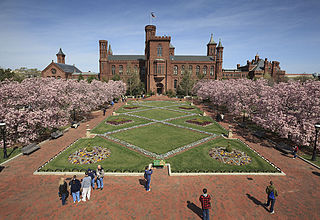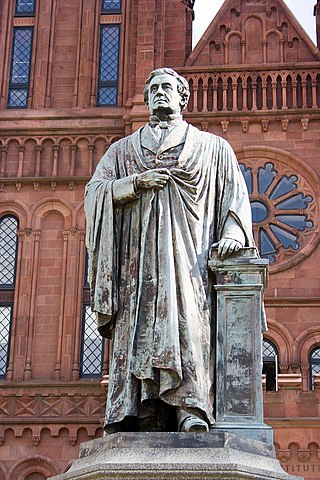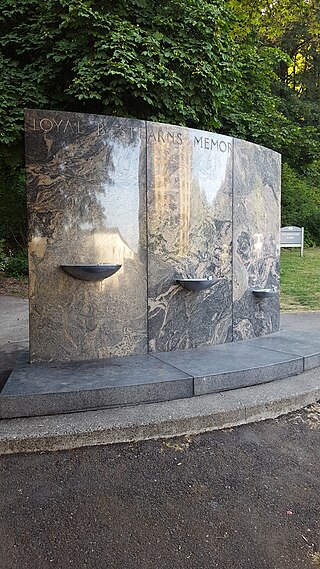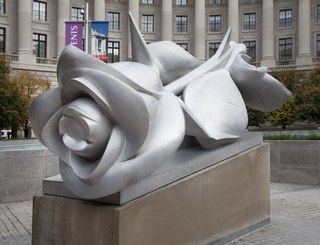
The Smithsonian Institution, or simply the Smithsonian, is a group of museums, education and research centers, the largest such complex in the world, created by the U.S. government "for the increase and diffusion of knowledge." Founded on August 10, 1846, it operates as a trust instrumentality and is not formally a part of any of the three branches of the federal government. The institution is named after its founding donor, British scientist James Smithson. It was originally organized as the United States National Museum, but that name ceased to exist administratively in 1967.

The National Mall is a landscaped park near the downtown area of Washington, D.C., the capital city of the United States. It contains and borders a number of museums of the Smithsonian Institution, art galleries, cultural institutions, and various memorials, sculptures, and statues. It is administered by the National Park Service (NPS) of the United States Department of the Interior as part of the National Mall and Memorial Parks unit of the National Park System. The park receives approximately 24 million visitors each year. Designed by Pierre L'Enfant, the "Grand Avenue" or Mall was to be a democratic and egalitarian space—unlike palace gardens, such as those at Versailles in France, that were paid for by the people but reserved for the use of a privileged few.

The Arthur M. Sackler Gallery is an art museum of the Smithsonian Institution in Washington, D.C., focusing on Asian art. The Sackler Gallery and the Freer Gallery of Art together form the National Museum of Asian Art in the United States. The Freer and Sackler galleries house the largest Asian art research library in the country.

The National Museum of American History: Kenneth E. Behring Center is a historical museum in Washington, D.C. It collects, preserves, and displays the heritage of the United States in the areas of social, political, cultural, scientific, and military history. Among the items on display is the original Star-Spangled Banner. The museum is part of the Smithsonian Institution and located on the National Mall at 14th Street and Constitution Avenue NW in Washington, D.C.

The Hirshhorn Museum and Sculpture Garden is an art museum beside the National Mall in Washington, D.C., United States. The museum was initially endowed during the 1960s with the permanent art collection of Joseph H. Hirshhorn. It was designed by architect Gordon Bunshaft and is part of the Smithsonian Institution. It was conceived as the United States' museum of contemporary and modern art and currently focuses its collection-building and exhibition-planning mainly on the post–World War II period, with particular emphasis on art made during the last 50 years.

The Smithsonian American Art Museum is a museum in Washington, D.C., part of the Smithsonian Institution. Together with its branch museum, the Renwick Gallery, SAAM holds one of the world's largest and most inclusive collections of art, from the colonial period to the present, made in the United States. More than 7,000 artists are represented in the museum's collection. Most exhibitions are held in the museum's main building, the Old Patent Office Building, while craft-focused exhibitions are shown in the Renwick Gallery.

Smithsonian Libraries and Archives is an institutional archives and library system comprising 21 branch libraries serving the various Smithsonian Institution museums and research centers. The Libraries and Archives serve Smithsonian Institution staff as well as the scholarly community and general public with information and reference support. Its collections number nearly 3 million volumes including 50,000 rare books and manuscripts.

General Philip Sheridan is a bronze sculpture that honors Civil War general Philip Sheridan. The monument was sculpted by Gutzon Borglum, best known for his design of Mount Rushmore. Dedicated in 1908, dignitaries in attendance at the unveiling ceremony included President Theodore Roosevelt, members of the President's cabinet, high-ranking military officers and veterans from the Civil War and Spanish–American War. The equestrian statue is located in the center of Sheridan Circle in the Sheridan-Kalorama neighborhood of Washington, D.C. The bronze statue, surrounded by a plaza and park, is one of eighteen Civil War monuments in Washington, D.C., which were collectively listed on the National Register of Historic Places in 1978. The sculpture and surrounding park are owned and maintained by the National Park Service, a federal agency of the Interior Department.

The outdoor statue of Benjamin Franklin in Washington, D.C., is located near the intersection of 12th Street and Pennsylvania Avenue, in front of the Old Post Office. The statue was a gift from Stilson Hutchins, founder of The Washington Post, who wanted to display his and the newspaper's stature in the city. The designer, Ernst Plassmann, and sculptor, Jacques Jouvenal, were both German-American artists. The architect of the memorial was J. F. Manning.

Don Quixote is a 1976 sculpture by Aurelio Teno located at the northeast corner of the Kennedy Center in Washington, D.C. The sculpture of Don Quixote and his horse Rocinante was a gift from Spain for the United States Bicentennial.

The Smithsonian Gardens, a division of the Smithsonian Institution, is responsible for the "landscapes, interiorscapes, and horticulture-related collections and exhibits", which serve as an outdoor extension of the Smithsonian's museums and learning spaces in Washington, D.C. Established in 1972 as a groundskeeping and horticulture program, Smithsonian Gardens currently manages 180 acres of gardens on the National Mall, 64,000 square feet of greenhouse production space, and the Archives of American Gardens, a research collection of over 60,000 photographs and archival records covering American landscape history from the 1870s to the present.

Professor Joseph Henry, also known as the Joseph Henry Memorial, is an outdoor bronze sculpture depicting scientist Joseph Henry, the first president of the Smithsonian Institution. The statue stands in front of the Smithsonian Institution Building in Washington, D.C., facing the National Mall. It was sculpted by artist William Wetmore Story, and dedicated in 1883, a few years after Henry's death. The bronze statue and granite base were unveiled in front of thousands of onlookers and invited guests. Speeches at the dedication included one from Chief Justice of the Supreme Court Morrison Waite, and the president of Yale College, Noah Porter.

Present, also known as Future, is a 1935 outdoor sculpture by Robert Ingersoll Aitken, located in front of the National Archives Building in Washington, D.C., in the United States. John Russell Pope served as the sculpture's architect and Edward H. Ratti served as its carver. The sculpture is made of Indiana limestone and measures approximately 20 x 8 x 12 feet, with a base approximately 12 x 12 x 15 feet. Present is a companion piece to Past, also located in front of the National Archives Building.

The Quest, sometimes referred to as Saturday Night at the Y or Three Groins in a Fountain, is an outdoor marble sculpture and fountain designed by Count Alexander von Svoboda, located in Portland, Oregon in the United States. The sculpture, carved in Italy from a single 200-ton block of white Pentelic marble quarried in Greece, was commissioned by Georgia-Pacific in 1967 and installed in front of the Standard Insurance Center in 1970. It depicts five nude figures, including three females, one male and one child. According to the artist, the subjects represent man's eternal search for brotherhood and enlightenment.

The Loyal B. Stearns Memorial Fountain, also known as the Judge Loyal B. Stearns Memorial Fountain, is an outdoor 1941 drinking fountain and sculpture by the design firm A. E. Doyle and Associates, located in Portland, Oregon. It was erected in Washington Park in honor of the former Oregon judge Loyal B. Stearns.

Jason Lee, also known as Reverend Jason Lee, is an outdoor bronze sculpture of Jason Lee, located in Salem, Oregon, United States. It was designed by Alexander Phimister Proctor, who died in 1950 when only the work's model was finished. His son Gifford MacGregor Proctor completed the sculpture between 1950 and 1953. The one installed on the grounds of the Oregon State Capitol is a duplicate of a bronze statue unveiled in the United States Capitol in 1952.

Big Red, also known as Red, is an outdoor 1974 steel sculpture by Bruce Beasley, installed at West 7th Avenue between Washington and Jefferson streets in Eugene, Oregon, United States.

Federal Triangle Flowers is an outdoor 1998 sculptural work by Stephen Robin, installed in Woodrow Wilson Plaza, between the Ariel Rios Building and the Ronald Reagan Building and International Trade Center, in Washington, D.C., United States. The installation includes two pieces, one depicting a single stem rose and the other a lily. The cast-aluminum sculptures are set on limestone pedestals; both flowers measure approximately 10 feet (3.0 m) x 14 feet (4.3 m) x 7 feet (2.1 m).

Australian Seal is an outdoor sculpture of 1968–69 by Thomas Bass, installed outside the Embassy of Australia, Washington, D.C., in the United States. The bronze sculpture measures approximately 8 feet (2.4 m) x 5 feet (1.5 m) x 2 feet (0.61 m) and is set on a flagstone base. It depicts a kangaroo, emu, and the Australian shield, which includes images of St. George's Cross, Queen Victoria's crown, a Maltese Cross, magpie, black swan, and lions. Above the shield is a seven-pointed star.

George Washington is an outdoor equestrian statue by the Scottish-American sculptor J. Massey Rhind located in Washington Park in Newark, New Jersey. It depicts General George Washington saying farewell to the troops of the Continental Army on November 2, 1783, and was dedicated on the anniversary of that event in 1912.





















